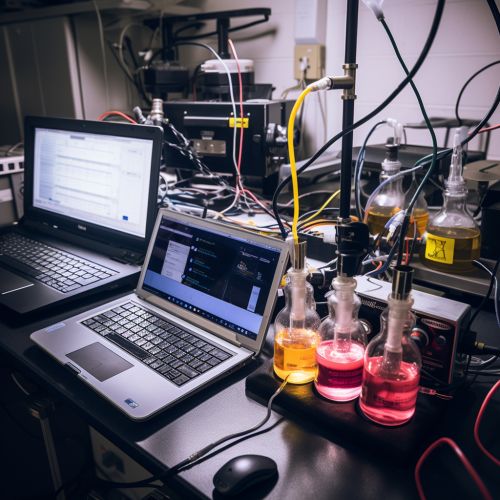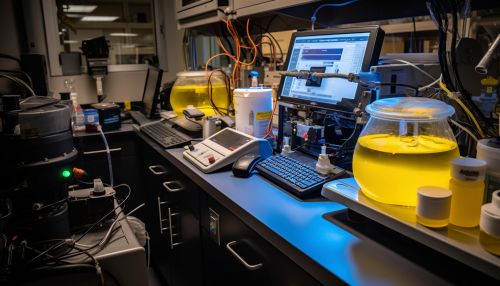Mechanochemistry
Introduction
Mechanochemistry is a branch of chemistry that involves the study of chemical reactions that occur due to mechanical forces. It is a multidisciplinary field that combines elements of physical chemistry, materials science, and mechanical engineering. Mechanochemistry is a rapidly growing field, with applications in a variety of industries, including pharmaceuticals, materials manufacturing, and environmental remediation.
History
The concept of mechanochemistry has been known since ancient times, with the earliest recorded use of mechanical force to initiate chemical reactions dating back to the 4th century BC. However, the term "mechanochemistry" was first coined in the early 20th century by the Russian scientist Nikolay Semenovich Semenov, who is also known for his work in the field of chemical kinetics. The field has since grown and evolved, with significant advancements being made in the latter half of the 20th century and the early 21st century.
Principles
Mechanochemistry involves the use of mechanical force to induce chemical reactions. This can be achieved through various methods, such as grinding, milling, shearing, or even sonication. These mechanical forces can cause changes in the physical and chemical properties of the substances involved, leading to the formation of new compounds or materials.
The exact mechanisms by which mechanochemical reactions occur are still not fully understood. However, it is generally accepted that the mechanical forces involved can cause changes in the electronic structure of the substances involved, leading to the formation of reactive species. These reactive species can then undergo further reactions, leading to the formation of new compounds or materials.
Mechanochemical reactions can occur in both solid and liquid phases, although the majority of research in the field has focused on solid-state reactions. These reactions are typically carried out in specialized equipment, such as ball mills or planetary mills, which can generate the necessary mechanical forces.

Applications
Mechanochemistry has a wide range of applications in various industries.
Pharmaceuticals
In the pharmaceutical industry, mechanochemistry is used in the synthesis of active pharmaceutical ingredients (APIs). Mechanochemical methods can offer several advantages over traditional solution-based synthesis methods, including reduced solvent use, shorter reaction times, and the ability to synthesize APIs with improved physical properties, such as increased solubility or stability.
Materials Manufacturing
In the field of materials manufacturing, mechanochemistry is used in the synthesis of a wide range of materials, including ceramics, metals, and polymers. Mechanochemical methods can offer several advantages over traditional manufacturing methods, including the ability to produce materials with unique properties, such as improved strength or durability.
Environmental Remediation
Mechanochemistry also has applications in the field of environmental remediation. For example, mechanochemical methods can be used to degrade persistent organic pollutants, such as polychlorinated biphenyls (PCBs), into less harmful substances.


Future Directions
The field of mechanochemistry is still rapidly evolving, with new applications and techniques being developed on a regular basis. Future directions for the field may include the development of new mechanochemical methods for the synthesis of complex organic compounds, the exploration of new mechanochemical reactions, and the development of new equipment for carrying out mechanochemical reactions.
See Also
- Physical Chemistry
- Materials Science
- Mechanical Engineering
- Pharmaceutical Industry
- Environmental Science
References
- ↑ James, S. L.; Adams, C. J.; Bolm, C.; Braga, D.; Collier, P.; Friščić, T.; Grepioni, F.; Harris, K. D. M.; Hyett, G.; Jones, W.; Krebs, A.; Mack, J.; Maini, L.; Orpen, A. G.; Parkin, I. P.; Shearouse, W. C.; Steed, J. W.; Waddell, D. C. (2012). "Mechanochemistry: Opportunities for new and cleaner synthesis". Chemical Society Reviews. 41 (1): 413–447. doi:10.1039/C1CS15171A. PMID 21909544.
- ↑ Friščić, T.; Mottillo, C.; Titi, H. M. (2020). "Mechanochemistry for Synthesis". Angewandte Chemie International Edition. 59 (5): 1018–1029. doi:10.1002/anie.201909987. PMID 31609070.
- ↑ Stolle, A.; Szuppa, T.; Leonhardt, S. E. S.; Ondruschka, B. (2011). "Ball milling in organic synthesis: solutions and challenges". Chemical Society Reviews. 40 (5): 2317–2329. doi:10.1039/c0cs00195c. PMID 21327264.
